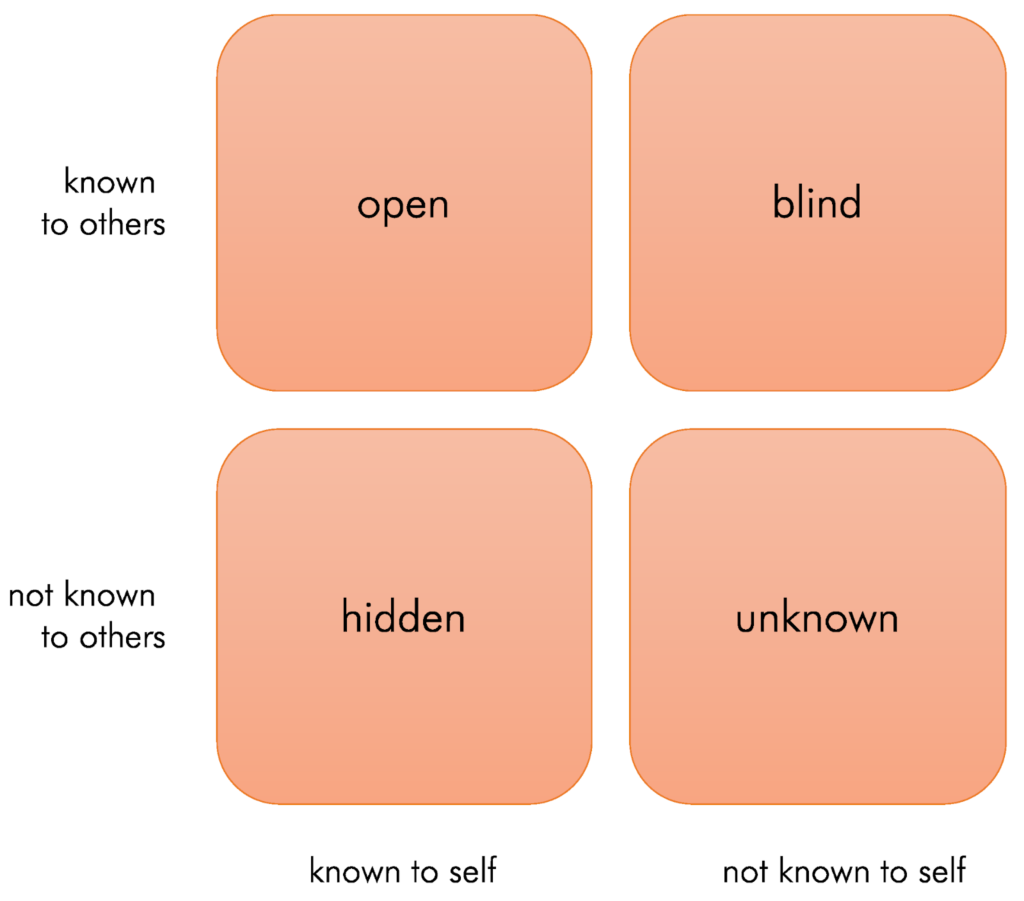The Johari window tells about the open, hidden,blind, unknown aspects of self and is used by me to collaborate with clients to examine areas of communication, commitment and conflict.University of California psychologists Joseph Luft (1916–2014) and Harrington Ingham (1916–1995) helped conceptualize a model which helps see an individual’s position in and their relationships and interactions with others in a group (Spennemann, 2023).
One exercise I encourage is to write a letter – to a loved one who has passed away- using the structure of the Johari Window and see how life changes, what things about oneself, relationships and society one can see after doing this exercise.
Case Scenario: A client in his thirties came to me with feelings of unease after having ended a decade long marriage, gone into another relationship which he broke up, and is now in a live-in relationship with another person, but has intrusive thoughts about his previous relationships.
Application– Through Transcript and Johari Window Exercises.
Transcript of Session.
Client ( C) : I cannot put my finger on it, but I have been feeling a bit off
Therapist (T-PB) : Is it a feeling of unease or tiredness or both
C- Unease about some memories of the previous relationships
T-PB: Is there a part of that joint energy which informs the present relationships.
C- Yes. Though they should not be coming up, I have to admit that these offsetting memories are coming up.
T-PB- Let us revisit our previous collaboration to examine the open and hidden shoulds which drive one’s thinking.
C- What purpose does that serve
T-PB- It is one of the tools one can use to deconstruct internal dialogue or interpersonal communications and create a safe space, structure and observer mind.
Psychoeducation Point: Open or Hidden Shoulds can be a road to Cognitive distortions which can be emotionally exhausting (you can download worksheet below)
Johari Window Exercises

The open self- what is known to both myself and others- can be truths which are undeniable over time, how they affected my relationships, especially with those I hurt, and what parts of me remained consistent and genuine. These can serve as a means to explore the personal and interpersonal dynamics, how they affect identity, isolation, meaning and freedom.
For example
C- We came together when we were in our teens. Despite her parents having warned her about me, she chose to be with me. However, around seven years after our marriage, we started drifting apart, staying together like hostel room members, avoiding any deeper discussion.
T-PB: How would she write about this phase?
This brings us to the blind self- what others can see, but I deny, or cannot see.
C- she would probably tell that I was aloof, got too busy in my work, started spending more time with my friends and was irritable when her family came to visit.
Th-PB- Did she try to mirror these aspects of your lived reality?
C-She did try to point out, but I was not open to these suggestions. At times I was very volatile, which made her shut down. Then we both got busy with our work, created our own separate friend circles and drifted apart.
Th-PB- Knowing what you know now, can you look back and see how your body language, tone, omissions affected the relationship?
C- It led to a feeling of loneliness, misunderstanding and feeling stifled.
T-PB: Did it lead to fear, confusion, entitlement
This leads one to the Hidden Self- What one knows but keeps hidden

C- Yes, it led to confusion and led me astray from my commitment to this relationship. There was a sense of shame as she had supported me in my very difficult teenage years. There was a sense of rejection as we became aloof and I started seeking emotional nurturing from others.
T-PB: What truths did you hide from yourself and others?
C- I cloaked these outside relationships by deflecting questions of where I was spending my time and with whom. I also started developing a sense of entitlement by blaming my partner for these secrets.
T-PB -Is there any pattern in your family of origin which you can see repeating?
C-I never thought about it like this, but that could be an area of enquiry
We agreed to journal about this and discuss as appropriate. This helped us to see the Unknown Self (not known to others and me, what I am only discovering now)
In next sessions we discussed themes of communication, how feelings were discussed or avoided in family of origin and how these truths were handled. To assist this exercise we did the Family Dinner in Childhood Exercise (an adaptation of Family Sculpting Tool suggested by Alfred Adler- see worksheet below)
C- A day in the life of the family, a dinner together led to some old wounds reopening.
T-PB: Therapy can get uneasy and difficult before things get better.
C-(smiling): Yes, I understand that process, but I needed to look at some buried issues which have been coming up in the way I communicate my needs and feelings.
T-PB: What cultural contexts did you revisit?
C- That was a different time, my parents had freshly moved to Canada. The stress of shifting and still having ties, pulls from the parent culture were telling on their relationship. Being stuck in survival level manual labour jobs added to their burdens.
T-PB: Can you now see the spaces which they had to navigate differently? What strengths are you building by going through this process?
..
Comments:

I first came to know of the Johari window during a training session with my supervisor. She taught me to see things from different hats, and at times not put on any hat (my own prejudices and presumptions) and just walk along with the client, see the world as they see it.
This led me to sit in cafes near the community housing of Black Creek areas where living poor, working rough is common. I would visit a client weekly during my training, and help her navigate her reality, widowed in 2019 just before Covid19, institutionalized in 2022, having a teenage daughter back home in Ghana, separated from her pre-teen son in Toronto. The Johari window helped me see the relational dynamics and my own areas for growth.
Psychotherapy is a form of caring which is different from psychiatry (which has become a titration of medicines) and will help see the forces, factors, DNA and development in a compassionate manner. As Carl Rogers said- “ The curious paradox is that when I accept myself just as I am, then I can change.”

References
Spennemann, D. H. (2023). The usefulness of the Johari Window for the Cultural Heritage Planning Process. Heritage, 6(1), 724-741.





